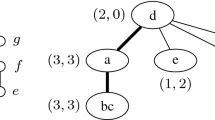Abstract
There are two well-known, elegant, compact, and efficiently computed representations of selected minimum edge cuts in a weighted, undirected graphG=(V, E) withn nodes andm edges: at one extreme, the Gomory-Hu cut tree [12] represents\(\left( {\begin{array}{*{20}c} n \\ 2 \\ \end{array} } \right)\) minimum cuts, one for each pair of nodes inG; at the other extreme, the Picard-Queyranne DAG [24] represents all the minimum cuts between a single pair of nodes inG. The GH cut tree is constructed with onlyn−1 max-flow computations, and the PQ DAG is constructed with one max-flow computation, plusO(m) additional time. In this paper we show how to marry these two representations, getting the best features of both. We first show that we can construct all\(\left( {\begin{array}{*{20}c} n \\ 2 \\ \end{array} } \right)\) DAGs, one for each fixed pair of nodes, using onlyn−1 max-flow computations as in [12], plusO(m) time per DAG as in [24]. This speeds up the obvious approach by a factor ofn. We then apply this approach to an unweighted graphG, to find all the edge-connectivity cuts inG, i.e., cuts with capacity equal to the connectivity ofG. Matula [22] gave a method to find one connectivity cut inO(nm) time; we show thatO(nm) time suffices to represent all connectivity cuts compactly, and to list all of them explicitly. This improves the previous best time bound ofO(n 2 m) [3] for listing the connectivity cuts. The connectivity cuts are central in network reliability calculations. We then show how to find all pairs of nodes that are separated by at least one connectivity cut inO(nm) time.
Similar content being viewed by others
References
G. M. Adelson-Velskii, E. A. Dinits, A. V. Karzanov,Flow Algorithms, Nauka, Moscow, 1976 (in Russian).
A. V. Aho, J. E. Hopcroft, J. D. Ullman,The Design and Analysis of Computer Algorithms, Addison-Wesley, Reading, MA, 1974.
M. O. Ball, J. S. Provan, Calculating Bounds on Reachability and Connectedness in Stochastic Networks,Networks,13 (1983), 253–278.
R. E. Bixby, The Minimum Number of Edges and Vertices in a Graph with Edge Connectivityn andm n-Bonds,Networks,5 (1975), 253–298.
C. J. Colbourn, D. D. Harms, Bounding All-Terminal Reliability in Computer Networks,Networks,18 (1988), 1–12.
E. A. Dinits, A. V. Karzanov, M. L. Lomosonov, On the Structure of a Family of Minimal Weighted Cuts in a Graph, inStudies in Discrete Optimization (A. A. Fridman, ed.), Nauka, Moscow, 1976, pp. 290–306 (in Russian).
A. H. Esfahanian, S. L. Hakimi, On Computing the Connectivities of Graphs and Digraphs,Networks,14 (1984), 355–366.
S. Even, R. E. Tarjan, Network Flow and Testing Graph Connectivity,SIAM J. Comput.,4 (1975), 507–518.
L. R. Ford, D. R. Fulkerson,Flows in Networks, Princeton University Press, Princeton, NJ, 1962.
G. Gallo, M. D. Grigoriadis, R. E. Tarjan, A Fast Parametric Maximum Flow Algorithm,SIAM J. Comput.,18 (1989), 30–55.
A. V. Goldberg, R. E. Tarjan, A New Approach to the Maximum Flow Problem,J. Assoc. Comput. Mach.,35(4) (1988), 921–940.
R. E. Gomory, T. C. Hu, Multi-Terminal Network Flows,SIAM J. Appl. Math.,9 (1961), 551–560.
F. Granot, R. Hassin, Multi-Terminal Maximum Flows in Node-Capacitated Networks,Discrete Appl. Math.,13 (1986), 157–163.
D. Gusfield, Three Fast Algorithms for Four Problems in Stable Marriage,SIAM J. Comput.,16(1) (1987), 111–128.
D. Gusfield, Very Simple Methods for All Pairs Network Flow Analysis,SIAM J. Comput.,19(1) (1990), 143–155.
D. Gusfield, D. Naor, Extracting Maximal Information About Sets of Minimum Cuts, Technical Report CSE-88-14, Computer Science Division, University of California, Davis, CA, September 1988.
D. Gusfield, D. Naor, Efficient Algorithms for Generalized Cut Trees,Networks,21(5) (1991), 505–520. Also inProc. First Annual ACM-SIAM Symposium on Discrete Algorithms, January 1990, San Francisco, CA, pp. 422–433.
R. Hassin, Solution Bases of Multi-Terminal Cut Problems,Math. Oper. Res.,13(4) (1988), 535–542.
A. Kanevsky, Graphs with Odd and Even Edge Connectivity are Inherently Different, Technical Report TAMU-89-10, Texas A&M University, College Station, TX, June 1989.
A. V. Karzanov, E. A. Timofeev, Efficient Algorithm for Finding All Minimal Edge Cuts of a Nonoriented Graph,Cybernetics,22(2) (1986), 156–162. (Translated fromKibernetika, no. 2 (1986), 8–12.)
Y. Mansour, B. Schieber, Finding the Edge Connectivity of Directed Graphs,J. Algorithms,10(1) (1989), 76–85.
D. Matula, Determining Edge Connectivity inO(nm), Proc. 28th Annual IEEE Symposium on Foundations of Computer Science, October 1987, Los Angeles, CA, pp. 249–251.
D. Naor, The Structure of Minimum Cuts with Applications to Edge-Augmentation, Ph.D. Thesis, University of California, Davis, CA, 1991.
J. C. Picard, M. Queyranne, On the Structure of All Minimum Cuts in a Network and Applications,Math. Programming Stud.,13 (1980), 8–16.
J. C. Picard, M. Queyranne, Selected Applications of Minimum Cuts in Networks,Inform-Canad. J. Oper. Res. Inform. Process.,20 (1982), 394–422.
J. S. Provan, D. R. Shier, A Paradigm for Listing (s-t) Cuts in Graphs, Technical Report UNC/OR TR91-3, Department of Operations Research, University of North Carolina, Chapel Hill, NC, February 1991.
A. Ramanathan, C. J. Colbourn, Counting Almost Minimum Cutsets with Reliability Applications,Math. Programming,39 (1987), 253–261.
C. P. Schnoor, Bottlenecks and Edge Connectivity in Unsymmetrical Networks,SIAM J. Comput.,8 (1979), 265–274.
G. Steiner, An Algorithm to Generate the Ideals of a Partial Order,Oper. Res. Lett.,5(6) (1986), 317–320.
Author information
Authors and Affiliations
Additional information
Communicated by David S. Johnson.
Research was partially supported by Grant CCR-8803704 from the National Science Foundation.
Rights and permissions
About this article
Cite this article
Gusfield, D., Naor, D. Extracting maximal information about sets of minimum cuts. Algorithmica 10, 64–89 (1993). https://doi.org/10.1007/BF01908632
Received:
Revised:
Issue Date:
DOI: https://doi.org/10.1007/BF01908632




